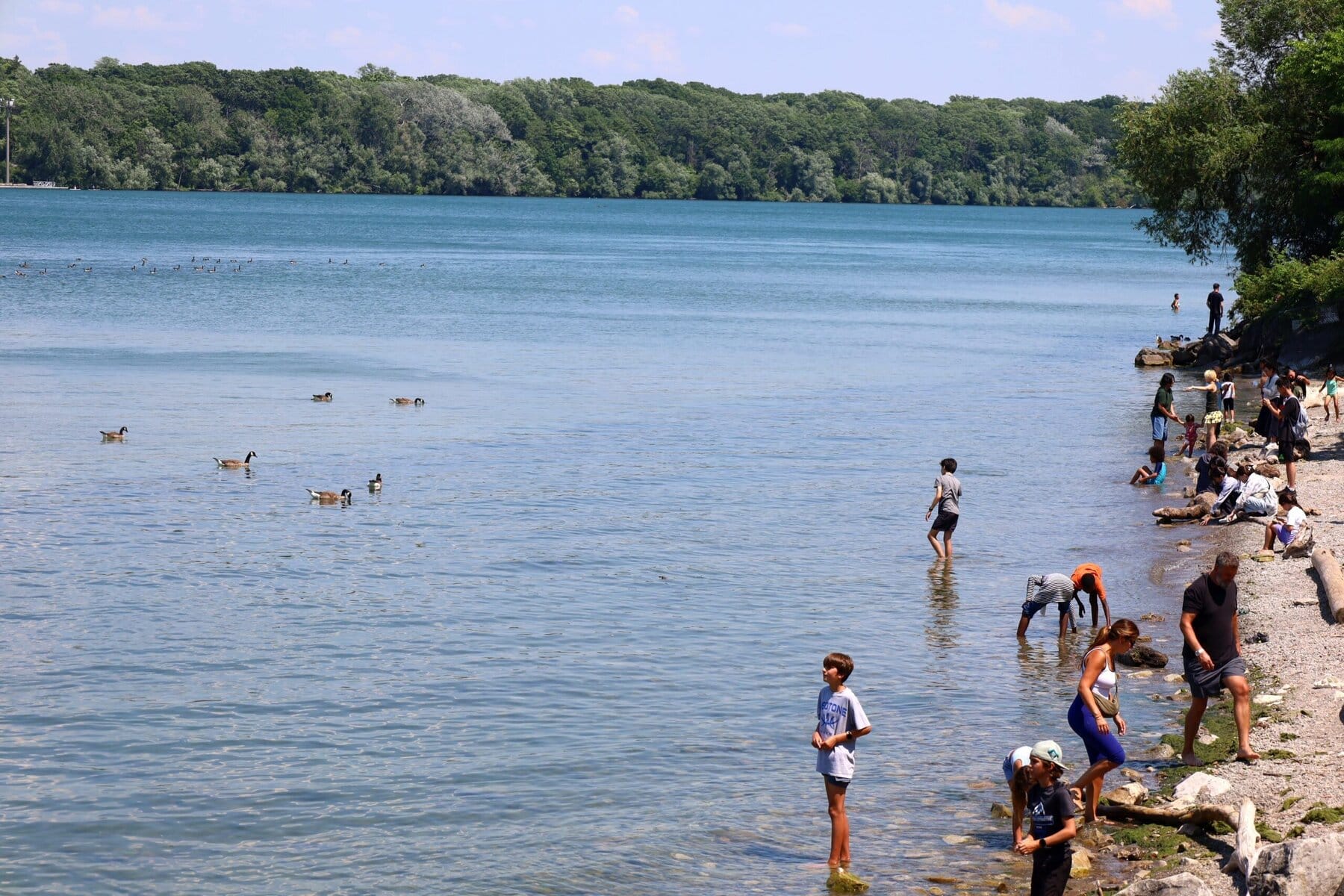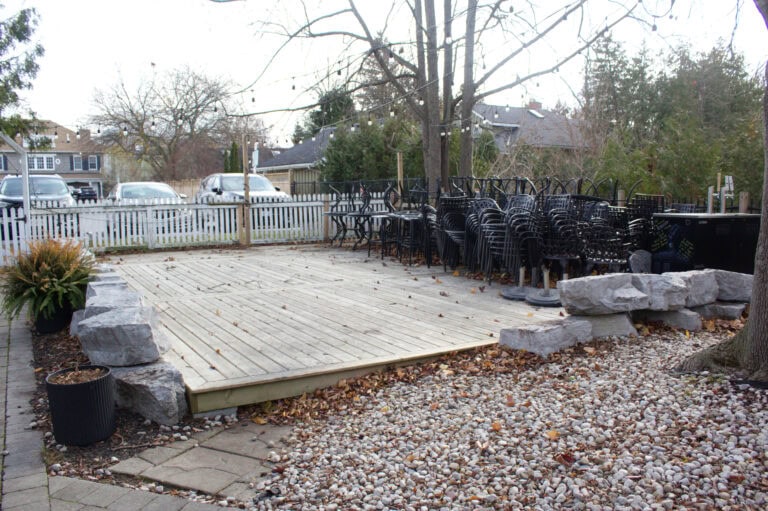The days of clear, bright warning signs are gone — at least at beaches in the Niagara region.
Now, beachgoers are expected to check the region’s website or assess real-time conditions themselves — a shift that left a Niagara-on-the-Lake councillor, along with some visitors at Queen’s Royal Beach last month, feeling uneasy.
Others, including Lord Mayor Gary Zalepa and the regional councillor who represents NOTL, Andrea Kaiser, say the current system has proven effective.
“I have a bit of a problem with the change in procedures,” said Coun. Sandra O’Connor, who plans to bring forward a motion to council about it. “I’d like to see something more proactive, by having signs say when it is not safe to swim.”
“I think that having all of council agree on this would offer more weight.”
Old yellow warning signs ‘can become outdated quickly’: public health unit
Each year from Victoria Day to Labour Day, Niagara Region Public Health monitors beaches and waterfronts, testing for E. coli, algae and things that raise safety concerns like debris or spills. Results are posted to the region’s beach safety webpage twice a week.
Queen’s Royal Beach in NOTL is tested on Tuesdays and Thursdays and results are posted on Wednesdays and Fridays, said Brandon Krupa, manager of the environmental health division for Niagara’s public health unit.
The region decided to phase out static warning signs several years ago, “because those signs can become outdated quickly,” said Meghan Marchand, manager of communications and engagement for the public health unit, in an email.
When bacteria levels are high, a swimming advisory is posted on the beach safety webpage.
Signs, rather — which Niagara Region prints and installs — are at beaches to give instructions for viewing water test results online and focus on real-time conditions swimmers can assess for themselves, said Krupa.
Conditions include recent heavy rain, wind and waves, cloudy water, large numbers of birds, or many swimmers in the area.
“In my opinion, it’s working,” said Kaiser. “In terms of technologies: Businesses (and) governments evolve as things change.”
She said it’s not about whether traditional or online methods are better — the online approach is simply “a different system,” though that’s not to say the old one didn’t have value.
Whereas, for Zalepa, the shift in signage was a “sign” of the times.
“I think, the old days — of having a sign that has to be changed every time — is probably not keeping with the times,” said Zalepa.
Zalepa said current signs give good direction: “I think it’s a pretty good process.”
Shift away from old signs to online creates ‘digital divide’: NOTL councillor
The town has no plans to develop its own beach safety signage system.
“We don’t have the expertise to do that,” he said. “If there’s suggestions to try something different or improve, I think Niagara Region and Public Health are open to that.”
If heading to a beach, Zalepa said he would do some “due diligence,” and check for potential concerns first. “If I had children with me — especially,” he added.
O’Connor said the shift away from traditional signage contributes to a “digital divide,” referring to the gap between people who can access and effectively use emerging technology and those who can’t.
“A lot of seniors — and we have a huge senior population — don’t know how to use QR codes,” she said. “This disparity can result in unequal opportunities for information like pollution warnings.”
It’s wrong to assume every resident has data on their phones, she said, arguing the system puts vulnerable groups, like seniors and those who can’t afford mobile data, at a disadvantage.
“These are the segments of our populations that we should be supporting,” she said.
Kaiser said for those without a mobile device, signs provide helpful indicators and other beachgoers are generally willing to share information. She also suggested visitors could ask for assistance at the town’s tourism office.
But still, she’s open to looking at how other regions handle beach safety and is willing to request more information at upcoming meetings if need be, she said.
O’Connor said residents should have received more clarity about the shift away from physical warning signs. “And I don’t think we’re communicating that message well enough,” she said.
Bacteria levels in water ‘change rapidly,’ region says
Lisa Cox, a spokesperson for Niagara’s public health unit, said it follows the same sampling process at all its beaches and looks at two things: The average of five or more samples and the result of any single sample.
Five samples are taken from roughly the same evenly spaced locations each time to ensure consistent results, Cox added.
Krupa said the region’s approach aims to share information as quickly and clearly as possible.
“Bacteria levels in beach water can change rapidly, often faster than static signs, like the old yellow sign … can reflect,” said Krupa, in an email. “Posting beach water quality results on our website provides instant updates as soon as results are received.”
That way, the region offers “one trusted source of information,” he said, and reflects “best practices in public health communication.”
This is another point that raises O’Connor’s eyebrow.
“You’re just testing it twice a week — and now you’re saying it can change rapidly,” she said.
“There seems to be a little bit of a disconnect, to me, in their statements there.”
Beach monitoring is a regional responsibility, O’Connor said, “but that doesn’t mean that all of the local government shouldn’t be taking a role into advising our people when there is a dangerous or hazardous situation.”
“I think that the best way to do this — to get a discussion — is to put in a motion,” said O’Connor. “And until I touch base with some of my councillors, I really don’t have any idea (what council might say).”
Reliance on QR codes and technology has also created barriers in other areas — like parking, she said. “I’ve heard several complaints from people that they can’t use our system.”
She’s raised these similar concerns to council before, but “they haven’t been onside,” she said.
“So whether they’ll be onside with this, because it’s a similar application, I do not know.”
Hamilton also posts signs directing beachgoers to check online or call for updates.
From the end of May until the end of August, six beaches in Hamilton are tested weekly on assigned weekdays and Pier 4 Beach is tested four times a week due to a history of high bacteria levels.
If an immediate health hazard is observed, the beach is closed with on-site signage, rather than marked simply unsafe for swimming. Hamilton Public Health then updates its website and phone line, said Matthew Lawson, manager of environmental health from Hamilton’s public health unit.
Nearby areas still post water safety warning signs
For other nearby regions, signs aren’t yet a thing of the past.
A spokesperson for Toronto Public Health said the city tests its beaches daily from June to September and if E. coli levels go over its water safety limit, signs are posted warning people not to swim.
Lifeguards also monitor safety conditions at Toronto beaches and use a flag system, which can change colours as conditions change throughout the day. Test results and water quality updates are also posted online.
At Halton Region beaches, signs are updated based on test results and beachgoers can also sign up for weekly emails or visit the region’s website for the latest updates, said a public health spokesperson. The region tests its beaches once a week from June to September.
Water at Niagara beaches is considered unsafe when the average of five or more samples exceeds 200 E. coli per 100 mL, or when any single sample is over 400. The same applies for Hamilton and Halton Region.
Other regions use a stricter standard. In Toronto, water is marked unsafe if the average E. coli level across five or more samples is over 100 per 100 mL, or if a single sample exceeds 200.
Niagara’s approach “is grounded in established public health principles,” said Marchand, adding swimmers can also use the region’s social media to make informed decisions about safety.
And the region “goes beyond the provincial requirement of one sample per week by conducting water testing twice weekly” at Queen’s Royal Beach, she said.
The sign there was replaced this summer — changing from a blue design without a QR code to a green one that includes one — but “the information on both is similar,” said Krupa.










